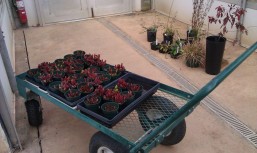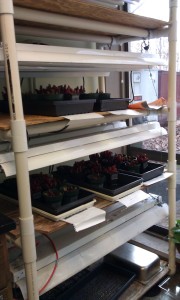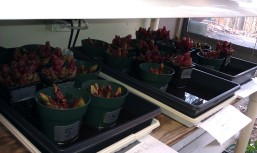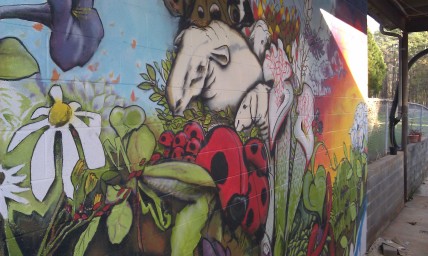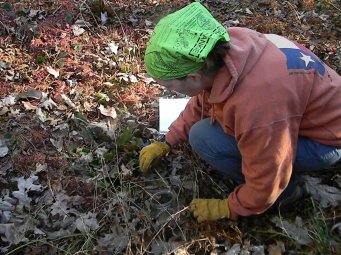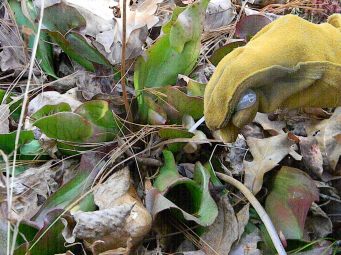Things have been trucking right along with the project, so much so that I’ve barely had a moment to myself, much less a moment to update the site. So I’m sure all of you, my loyal boggers are probably on the edge of your seats just waiting for some news…right? Well I won’t disappoint. The following covers just about everything that has been going on with the project since January. Enjoy!
Feeding Continues…
 All through January and February the plants were fed according to their grouping. Because it can be a long and tedious process I ended up recruiting several helpers on more than a few occasions to help get the job done. Thanks guys! Although it may seem like I gripe about the feeding, it is actually probably my favorite part of the project. The real work comes when I have to take measurements. As I mentioned in the last post, this involves regular monitoring of specific health factors such as each plants’ growth (or lack of growth) which is represented by height (mm) and new growth, represented by the number of new traps and new phyllodial (non-trap) leaves. In addition I am also measuring the pH and temperature (C°) of each trap of each plant… talk about work that can become tedious…
All through January and February the plants were fed according to their grouping. Because it can be a long and tedious process I ended up recruiting several helpers on more than a few occasions to help get the job done. Thanks guys! Although it may seem like I gripe about the feeding, it is actually probably my favorite part of the project. The real work comes when I have to take measurements. As I mentioned in the last post, this involves regular monitoring of specific health factors such as each plants’ growth (or lack of growth) which is represented by height (mm) and new growth, represented by the number of new traps and new phyllodial (non-trap) leaves. In addition I am also measuring the pH and temperature (C°) of each trap of each plant… talk about work that can become tedious…
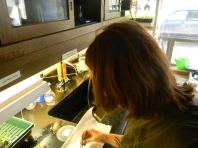 However the work is certainly starting to pay off as I am already starting to see some interesting trends in my data. And while I can’t state anything definitive until I have collected all my data and then run all my statistical analysis, I can say that I am getting excited to see my final results! How about you? Have any thoughts on what the data might tell me? I’d love to hear your thoughts. I especially love hearing from my young scientist friends who have been collaborating and following the project. Take a moment to send your hypothesis in the comments section at the bottom of the post! I will make sure to address it in my next post! The best ideas and comments I get will get included in the Students Speak section of the Bog in a Box curriculum! So put your thinking caps on and get to writing!
However the work is certainly starting to pay off as I am already starting to see some interesting trends in my data. And while I can’t state anything definitive until I have collected all my data and then run all my statistical analysis, I can say that I am getting excited to see my final results! How about you? Have any thoughts on what the data might tell me? I’d love to hear your thoughts. I especially love hearing from my young scientist friends who have been collaborating and following the project. Take a moment to send your hypothesis in the comments section at the bottom of the post! I will make sure to address it in my next post! The best ideas and comments I get will get included in the Students Speak section of the Bog in a Box curriculum! So put your thinking caps on and get to writing!
Round 2 Begins
 The first round of feeding trials wrapped up at the end of February. At that point I began to analyze my data, looking for patterns while my plants, troopers that they are, took a rest before the second round of trials. If it sounds like I am humanizing my plants, I probably am and do. I know I have caught myself talking to them during long hours alone in the lab. But I’m not ashamed, after all who doesn’t become attached to their work? (haha!) Do you ever talk to your house plants? Do you think it helps them grow? I happen to think it does, and there are many who agree with me, including the show Mythbusters. For those who prefer a more scientific resource over a television show however, there has actually been a by-the-book scientific study done by the Royal Horticultural Society that published the same conclusions. So maybe me talking to my research plants isn’t so nutty after all!
The first round of feeding trials wrapped up at the end of February. At that point I began to analyze my data, looking for patterns while my plants, troopers that they are, took a rest before the second round of trials. If it sounds like I am humanizing my plants, I probably am and do. I know I have caught myself talking to them during long hours alone in the lab. But I’m not ashamed, after all who doesn’t become attached to their work? (haha!) Do you ever talk to your house plants? Do you think it helps them grow? I happen to think it does, and there are many who agree with me, including the show Mythbusters. For those who prefer a more scientific resource over a television show however, there has actually been a by-the-book scientific study done by the Royal Horticultural Society that published the same conclusions. So maybe me talking to my research plants isn’t so nutty after all!
 Okay, back to my preliminary data: For those of you following the project from your classrooms, think about what it means to analyze data and look for patterns. What might I be looking for? Do you remember my hypotheses? If not jump over to the About the Project page and take a quick look to refresh your memory. Remember that my primary concern when I designed this study, was to determine if an introduced invasive species like fire ants, would end up causing detrimental ecosystem-wide effects to the mountain bogs where my rare plants are an anchor species. In case you have forgotten, being an anchor species for an ecosystem means that you provide important ecosystem services to so many different members of the community that without you, the system falters and eventually collapses. This makes anchor species extremely important when it comes to conserving specific habitats. The Mountain purple pitcherplant provides a safe haven for the larval stages of many invertebrates found nowhere else. These invertebrates then become food for a number of small reptiles, amphibians, birds and even mammals that make the bog their home. Ecosystems are both complex and simple in that they involve many characters, but all are in balance with one another like a house of cards. Remove one and the rest will come tumbling down.
Okay, back to my preliminary data: For those of you following the project from your classrooms, think about what it means to analyze data and look for patterns. What might I be looking for? Do you remember my hypotheses? If not jump over to the About the Project page and take a quick look to refresh your memory. Remember that my primary concern when I designed this study, was to determine if an introduced invasive species like fire ants, would end up causing detrimental ecosystem-wide effects to the mountain bogs where my rare plants are an anchor species. In case you have forgotten, being an anchor species for an ecosystem means that you provide important ecosystem services to so many different members of the community that without you, the system falters and eventually collapses. This makes anchor species extremely important when it comes to conserving specific habitats. The Mountain purple pitcherplant provides a safe haven for the larval stages of many invertebrates found nowhere else. These invertebrates then become food for a number of small reptiles, amphibians, birds and even mammals that make the bog their home. Ecosystems are both complex and simple in that they involve many characters, but all are in balance with one another like a house of cards. Remove one and the rest will come tumbling down.
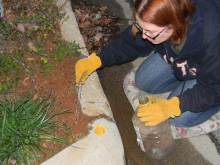 After nearly a month off, it was time to put the plants to work again and so Round 2 began on April 2nd. It was nice to get back into the lab, and back to feeding the plants after several weeks of just looking at graphs and trying to analyze what can seem like miles and miles of numbers… otherwise known as my data. Don’t think I wasn’t busy though. The warmer weather brought with it the return of many types of insects, awakening from their long winter dormancy, including ants. For me that means a return to the field to trap fire ants for Round 2. This time I didn’t have to travel far to find the mounds, as there were so many right in my own neighborhood. I am thankful that I pretty much have my method down after so many false starts during Round 1, and so far I’ve captured almost enough ants for the entire second round of feeding with no bites (yippee!) so far.
After nearly a month off, it was time to put the plants to work again and so Round 2 began on April 2nd. It was nice to get back into the lab, and back to feeding the plants after several weeks of just looking at graphs and trying to analyze what can seem like miles and miles of numbers… otherwise known as my data. Don’t think I wasn’t busy though. The warmer weather brought with it the return of many types of insects, awakening from their long winter dormancy, including ants. For me that means a return to the field to trap fire ants for Round 2. This time I didn’t have to travel far to find the mounds, as there were so many right in my own neighborhood. I am thankful that I pretty much have my method down after so many false starts during Round 1, and so far I’ve captured almost enough ants for the entire second round of feeding with no bites (yippee!) so far.
 In addition to trapping ants and analyzing data, I have also been working on the Bog in a Box program, outlining the project curriculum, refining the existing K-12 activities and adding new ones. I have been lucky in that I have gotten to work with some great students and teachers during this time, and so far the Project is shaping up to be even better than I ever hoped it would be. Once finished there will be a complete curriculum addition for K-12 focused on resource conservation, ecology, life science and biology that meets the state science standards for each grade accordingly. If you are a teacher or student interested in using the curriculum, make sure to keep checking the Bog in a Box page for updates and activities. The final project should be uploaded sometime shortly before the beginning of the 2013-2014 school year. Have an idea or want to contribute to the project in some way? I am always open to collaboration with both students and teachers. Leave a note in the comments section below, on the Bog in a Box page or send me an email and I’ll be sure to get back with you!
In addition to trapping ants and analyzing data, I have also been working on the Bog in a Box program, outlining the project curriculum, refining the existing K-12 activities and adding new ones. I have been lucky in that I have gotten to work with some great students and teachers during this time, and so far the Project is shaping up to be even better than I ever hoped it would be. Once finished there will be a complete curriculum addition for K-12 focused on resource conservation, ecology, life science and biology that meets the state science standards for each grade accordingly. If you are a teacher or student interested in using the curriculum, make sure to keep checking the Bog in a Box page for updates and activities. The final project should be uploaded sometime shortly before the beginning of the 2013-2014 school year. Have an idea or want to contribute to the project in some way? I am always open to collaboration with both students and teachers. Leave a note in the comments section below, on the Bog in a Box page or send me an email and I’ll be sure to get back with you!
Working with Future Scientists
I have had the honor and privilege of working with several different groups of students over the last couple of months, so I want to take a moment to thank them for not only taking an interest in the Project, but for taking an interest in conservation-ecology and science in general. No matter where they go in life, or what they choose to do for their own career, they will go forward from here, right now and today with an excellent understanding of conservation, what it means to them, why science is important, and how it relates to everyday life and the things they care about. Seeing their faces light up each and every time I visited a classroom, hearing their ideas on creating a better, more sustainable future and working with them to learn about creating their own Bog in a Box, truly made me feel like I had made a difference in their lives. They certainly changed mine…for the better. So I want to send a very special thanks to the Ms. Drummond’s 3rd grade class at Winterville Elementary, the 7th graders at Hillsman middle school, and of course the kids right here at Statham Elementary.
Interested in having me come out and work with your students or group? Leave a note in the comments section here or on the Bog in a Box page. You can also send me an email.
Okay, it is time for me to get back to the plants for now. But stay tuned as the end of the project is drawing near!! I will leave you with these images: Progress pictures of one of my plants…first photographed before the feeding trials, another in the middle and then one during the waiting period between feeding trials, and the last at the beginning of the second feeding trial. Can you guess which group this plant is in?

1-18-13
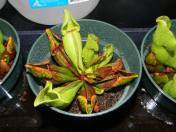
2-8-2013

3-21-2013


